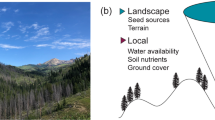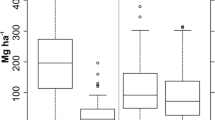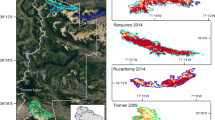Abstract
Context
Resilience in fire-prone forests is strongly affected by landscape burn-severity patterns, in part by governing propagule availability around stand-replacing patches in which all or most vegetation is killed. However, little is known about drivers of landscape patterns of stand-replacing fire, or whether such patterns are changing during an era of increased wildfire activity.
Objectives
(a) Identify key direct/indirect drivers of landscape patterns of stand-replacing fire (e.g., size, shape of patches), (b) test for temporal trends in these patterns, and (c) anticipate thresholds beyond which landscape patterns of burn severity may change fundamentally.
Methods
We applied structural equation modeling to satellite burn-severity maps of fires in the US Northern Rocky Mountains (1984–2010) to test for direct and indirect (via influence on fire size and proportion stand-replacing) effects of climate/weather, vegetation, and topography on landscape patterns of stand-replacing fire. We also tested for temporal trends in landscape patterns.
Results
Landscape patterns of stand-replacing fire were strongly controlled by fire size and proportion stand-replacing, which were, in turn, controlled by climate/weather and vegetation/topography, respectively. From 1984 to 2010, the proportion of stand-replacing fire within burn perimeters increased from 0.22 to 0.27. Trends for other landscape metrics were not significant, but may respond to further increases proportion stand-replacing fire.
Conclusions
Fires from 1984 to 2010 exhibited tremendous heterogeneity in landscape patterns of stand-replacing fire, likely promoting resilience in burned areas. If trends continue on the current trajectory, however, fires may produce larger and simpler shaped patches of stand-replacing fire with more burned area far from seed sources.







Similar content being viewed by others
References
Abatzoglou JT, Kolden CA (2013) Relationships between climate and macroscale area burned in the western United States. Int J Wildland Fire 22:1003–1020
Andrus RA, Veblen TT, Harvey BJ, Hart SJ (2016) Fire severity unaffected by spruce beetle outbreak in spruce-fir forests of southwestern Colorado. Ecol Appl 26(3):700–711
Attiwill PM (1994) The disturbance of forest ecosystems: the ecological basis for conservative management. For Ecol Manag 63:247–300
Baker WL (2009) Fire ecology in Rocky Mountain landscapes, 1st edn. Island Press, Washington
Belote RT (2015) Contemporary patterns of burn severity heterogeneity from fires in the Northwestern U.S. U.S. Department of Agriculture, Forest Service, Rocky Mountain Research Station, Fort Collins, CO
Bessie WC, Johnson EA (1995) The Relative Importance of Fuels and Weather on Fire Behavior in Subalpine Forests. Ecology 76:747–762
Birch DS, Morgan P, Kolden CA, Abatzoglou JT, Dillon GK, Hudak AT, Smith AMS (2015) Vegetation, topography and daily weather influenced burn severity in central Idaho and western Montana forests. Ecosphere 6:art17
Boyce MS, Mao JS, Merrill EH, Fortin D, Turner MG, Fryxell J, Turchin P (2003) Scale and heterogeneity in habitat selection by elk in Yellowstone National Park. Ecoscience 10:421–431
Byrnes J (2012) lavaan.modavg.R. http://jarrettbyrnes.info/ubc_sem/lavaan_materials/lavaan.modavg.R
Cansler CA, McKenzie D (2012) How robust are burn severity indices when applied in a new region? Evaluation of alternate field-based and remote-sensing methods. Remote Sens 4:456–483
Cansler CA, McKenzie D (2014) Climate, fire size, and biophysical setting control fire severity and spatial pattern in the northern Cascade Range, USA. Ecol Appl 24:1037–1056
Dennison PE, Brewer SC, Arnold JD, Moritz MA (2014) Large wildfire trends in the western United States, 1984–2011. Geophys Res Lett 41:2928–2933
Dickson BG, Prather JW, Xu Y, Hampton HM, Aumack EN, Sisk TD (2006) Mapping the probability of large fire occurrence in northern Arizona, USA. Landscape Ecol 21:747–761
Dillon GK, Holden ZA, Morgan P, Crimmins MA, Heyerdahl EK, Luce CH (2011) Both topography and climate affected forest and woodland burn severity in two regions of the western US, 1984 to 2006. Ecosphere 2:1–33
Donato DC, Fontaine JB, Campbell JL, Robinson WD, Kauffman JB, Law BE (2009) Conifer regeneration in stand-replacement portions of a large mixed-severity wildfire in the Klamath Siskiyou Mountains. Can J For Res 39:823–838
Eidenshink J, Schwind B, Brewer K, Zhu Z, Quayle B, Howard S (2007) A project for monitoring trends in burn severity. Fire Ecol 3:3–21
Falk D, Miller C, McKenzie D, Black A (2007) Cross-scale analysis of fire regimes. Ecosystems 10:809–823
Flannigan M, Cantin AS, de Groot WJ, Wotton M, Newbery A, Gowman LM (2013) Global wildland fire season severity in the 21st century. For Ecol Manag 294:54–61
Flannigan MD, Krawchuk MA, de Groot WJ, Wotton BM, Gowman LM (2009) Implications of changing climate for global wildland fire. Int J Wildland Fire 18:483–507
Gardner RH, Milne BT, Turnei MG, O’Neill RV (1987) Neutral models for the analysis of broad-scale landscape pattern. Landscape Ecol 1:19–28
Gauthier S, Bernier P, Kuuluvainen T, Shvidenko AZ, Schepaschenko DG (2015) Boreal forest health and global change. Science 349:819–822
Grace JB (2006) Structural equation modeling and natural systems, 1st edn. Cambridge University Press, Cambridge
Grace JB, Keeley JE (2006) A structural equation model analysis of postfire plant diversity in California shrublands. Ecol Appl 16:503–514
Greene DF, Johnson EA (1996) Wind dispersal of seeds from a forest into a clearing. Ecology 77:595–609
Gustafson EJ, Parker GR (1992) Relationships between landcover proportion and indices of landscape spatial pattern. Landscape Ecol 7:101–110
Halofsky JE, Donato DC, Hibbs DE, Campbell JL, Cannon MD, Fontaine JB, Thompson JR, Anthony RG, Bormann BT, Kayes LJ, Law BE, Peterson DL, Spies TA (2011) Mixed-severity fire regimes: lessons and hypotheses from the Klamath-Siskiyou Ecoregion. Ecosphere 2:art40
Harvey BJ (2015) Causes and consequences of spatial patterns of fire severity in Northern Rocky Mountain Forests: the role of disturbance interactions and changing climate. PhD Dissertation, University of Wisconsin—Madison
Harvey BJ, Donato DC, Romme WH, Turner MG (2013) Influence of recent bark beetle outbreak on fire severity and postfire tree regeneration in montane Douglas-fir forests. Ecology 94:2475–2486
Harvey BJ, Donato DC, Romme WH, Turner MG (2014a) Fire severity and tree regeneration following bark beetle outbreaks: the role of outbreak stage and burning conditions. Ecol Appl 24:1608–1625
Harvey BJ, Donato DC, Turner MG (2014b) Recent mountain pine beetle outbreaks, wildfire severity, and postfire tree regeneration in the US Northern Rockies. Proc Natl Acad Sci 111:15120–15125
Harvey BJ, Donato DC, Turner MG (2016a) Burn me twice, shame on who? interactions between successive forest fires across a temperate mountain region. Ecology. doi:10.1002/ecy.1439
Harvey BJ, Donato DC, Turner MG (2016b) High and dry: postfire drought and large stand replacing burn patches reduce postfire tree regeneration in subalpine forests. Glob Ecol Biogeogr 25:655–669
Hessburg PF, Salter RB, James KM (2007) Re-examining fire severity relations in pre-management era mixed conifer forests: inferences from landscape patterns of forest structure. Landscape Ecol 22:5–24
Holden ZA, Morgan P, Evans JS (2009) A predictive model of burn severity based on 20-year satellite-inferred burn severity data in a large southwestern US wilderness area. For Ecol Manag 258:2399–2406
Jenness JS (2004) Calculating landscape surface area from digital elevation models. Wildl Soc Bull 32:829–839
Jolly WM, Cochrane MA, Freeborn PH, Holden ZA, Brown TJ, Williamson GJ, Bowman DMJS (2015) Climate-induced variations in global wildfire danger from 1979 to 2013. Nat Commun 6:7537
Kashian DM, Romme WH, Tinker DB, Turner MG, Ryan MG (2006) Carbon storage on landscapes with stand-replacing fires. Bioscience 56:598–606
Keeley JE (2009) Fire intensity, fire severity and burn severity: a brief review and suggested usage. Int J Wildland Fire 18:116–126
Kemp KB, Higuera PE, Morgan P (2015) Fire legacies impact conifer regeneration across environmental gradients in the U.S. northern Rockies. Landscape Ecol 31(3):619–636
Littell JS, McKenzie D, Peterson DL, Westerling AL (2009) Climate and wildfire area burned in western U.S. ecoprovinces, 1916–2003. Ecol Appl 19:1003–1021
McGarigal K, Cushman SA, Ene E (2012) FRAGSTATS v4: spatial pattern analysis program for categorical and continuous maps. University of Massachusetts, Amherst
Meigs GW, Turner DP, Ritts WD, Yang Z, Law BE (2011) Landscape-scale simulation of heterogeneous fire effects on pyrogenic carbon emissions, tree mortality, and net ecosystem production. Ecosystems 14:758–775
Millar CI, Stephenson NL (2015) Temperate forest health in an era of emerging megadisturbance. Science 349:823–826
Miller JD, Thode AE (2007) Quantifying burn severity in a heterogeneous landscape with a relative version of the delta Normalized Burn Ratio (dNBR). Remote Sens Environ 109:66–80
Miller JD, Safford HD, Crimmins M, Thode AE (2009) Quantitative evidence for increasing forest fire severity in the Sierra Nevada and Southern Cascade Mountains, California and Nevada, USA. Ecosystems 12:16–32
Morgan P, Heyerdahl EK, Gibson CE (2008) Multi-season climate synchronized forest fires throughout the 20th century, Northern Rockies, USA. Ecology 89:717–728
Morgan P, Heyerdahl EK, Miller C, Wilson AM, Gibson CE (2014) Northern Rockies pyrogeography: an example of fire atlas utility. Fire Ecol 10:14–30
Moritz MA, Parisien M-A, Batllori E, Krawchuk MA, Van Dorn J, Ganz DJ, Hayhoe K (2012) Climate change and disruptions to global fire activity. Ecosphere 3:art49
Parks SA, Miller C, Nelson CR, Holden ZA (2014) Previous fires moderate burn severity of subsequent wildland fires in two large western US wilderness areas. Ecosystems 17:29–42
Parks SA, Holsinger LM, Miller C, Nelson CR (2015) Wildland fire as a self-regulating mechanism: the role of previous burns and weather in limiting fire progression. Ecol Appl 25:1478–1492
Perry DA, Hessburg PF, Skinner CN, Spies TA, Stephens SL, Taylor AH, Franklin JF, McComb B, Riegel G (2011) The ecology of mixed severity fire regimes in Washington, Oregon, and Northern California. For Ecol Manag 262:703–717
Pickett ST, White PS (1985) The ecology of natural disturbance and patch dynamics. Academic Press, Orlando
Prichard SJ, Kennedy MC (2014) Fuel treatments and landform modify landscape patterns of burn severity in an extreme fire event. Ecol Appl 24:571–590
R Development Core Team (2012) R: a language and environment for statistical computing. R Foundation for Statistical Computing, Vienna
Riley KL, Abatzoglou JT, Grenfell IC, Klene AE, Heinsch FA (2013) The relationship of large fire occurrence with drought and fire danger indices in the western USA, 1984–2008: the role of temporal scale. Int J Wildland Fire 22:894–909
Rollins MG (2009) LANDFIRE: a nationally consistent vegetation, wildland fire, and fuel assessment. Int J Wildland Fire 18:235–249
Rollins MG, Morgan P, Swetnam T (2002) Landscape-scale controls over 20th century fire occurrence in two large Rocky Mountain (USA) wilderness areas. Landscape Ecol 17:539–557
Romme WH (1982) Fire and landscape diversity in subalpine forests of Yellowstone National Park. Ecol Monogr 52:199
Romme W, Boyce M, Gresswell R, Merrill EH, Minshall GW, Whitlock C, Turner MG (2011) Twenty years after the 1988 Yellowstone fires: lessons about disturbance and ecosystems. Ecosystems 14:1196–1215
Rosseel Y (2012) Lavaan: an R package for structural equation modeling. J Stat Softw 48:1–36
Schoennagel T, Veblen TT, Romme WH (2004) The interaction of fire, fuels, and climate across Rocky Mountain forests. Bioscience 54:661
Schoennagel T, Smithwick EAH, Turner MG (2008) Landscape heterogeneity following large fires: insights from Yellowstone National Park, USA. Int J Wildland Fire 17:742–753
Sherriff RL, Platt RV, Veblen TT, Schoennagel TL, Gartner MH (2014) Historical, Observed, and Modeled Wildfire Severity in Montane Forests of the Colorado Front Range. PLoS ONE 9:e106971
Thompson JR, Spies TA (2009) Vegetation and weather explain variation in crown damage within a large mixed-severity wildfire. For Ecol Manag 258:1684–1694
Trumbore S, Brando P, Hartmann H (2015) Forest health and global change. Science 349:814–818
Turner MG, Baker WL, Peterson CJ, Peet RK (1998) Factors influencing succession: lessons from large, infrequent natural disturbances. Ecosystems 1:511–523
Turner MG, Donato DC, Romme WH (2013) Consequences of spatial heterogeneity for ecosystem services in changing forest landscapes: priorities for future research. Landscape Ecol 28:1081–1097
Turner MG, Hargrove WW, Gardner RH, Romme WH (1994) Effects of fire on landscape heterogeneity in Yellowstone National Park, Wyoming. J Veg Sci 5:731–742
Turner MG, Romme WH (1994) Landscape dynamics in crown fire ecosystems. Landscape Ecol 9:59–77
Turner MG, Romme WH, Gardner RH, Hargrove WW (1997) Effects of fire size and pattern on early succession in Yellowstone National Park. Ecol Monogr 67:411–433
Turner M, Romme W, Reed R, Tuskan G (2003) Post-fire aspen seedling recruitment across the Yellowstone (USA) Landscape. Landscape Ecol 18:127–140
Turner MG, Tinker DB, Romme WH, Kashian DM, Litton CM (2004) Landscape patterns of sapling density, leaf area, and aboveground net primary production in postfire lodgepole pine forests, Yellowstone National Park (USA). Ecosystems 7:751–775
Walker B, Hollin CS, Carpenter SR, Kinzig A (2004) Resilience, adaptability and transformability in social-ecological systems. Ecol Soc 9(2):5
Westerling AL, Hidalgo HG, Cayan DR, Swetnam TW (2006) Warming and earlier spring increase western US forest wildfire activity. Science 313:940
Westerling AL, Turner MG, Smithwick EAH, Romme WH, Ryan MG (2011) Continued warming could transform Greater Yellowstone fire regimes by mid-21st century. Proc Natl Acad Sci 108:13165–13170
Wu Z, He HS, Liang Y, Cai L, Lewis BJ (2013) Determining relative contributions of vegetation and topography to burn severity from LANDSAT imagery. Environ Manage 52:821–836
Acknowledgments
We thank W. Romme for stimulating discussions leading to the conception of this study. L. Westerling and J. Milostan provided invaluable assistance with climate data. B. Weiland, T. Butusov. C. Lane, N. LaBonte, S. Armstrong, A. Meiritz, Z. Osterholz, D. Guerrero-Harvey, C. Harvey, M. Harvey helped with fieldwork. S. Kochaver, K. Burkhard, S. Winter, K. Budke, S. Rosenberg, A. Singh and P. Townsend helped with data processing and models of RdNBR versus fire severity. J. Miller provided assistance with statistical analysis. E. Damschen, P. Townsend, K. Raffa, J. Williams, and three anonymous reviewers provided valuable feedback on earlier drafts of this manuscript. This study was funded by a Graduate Research Innovation Award from the US Joint Fire Science Program (Award # 12-3-01-3) and the US National Park Service—George Melendez Wright Climate Change Fellowship.
Author information
Authors and Affiliations
Corresponding author
Electronic supplementary material
Below is the link to the electronic supplementary material.
Rights and permissions
About this article
Cite this article
Harvey, B.J., Donato, D.C. & Turner, M.G. Drivers and trends in landscape patterns of stand-replacing fire in forests of the US Northern Rocky Mountains (1984–2010). Landscape Ecol 31, 2367–2383 (2016). https://doi.org/10.1007/s10980-016-0408-4
Received:
Accepted:
Published:
Issue Date:
DOI: https://doi.org/10.1007/s10980-016-0408-4




